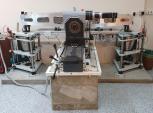Standard name: National Standard of Torque EZMS 1 kN.m
Code designation: ECM 150-6/06-032
Year of publication: 2006
Department: nr. 8011 CMI LPM Praha
Guarantor: Ing. Lukáš Vavrečka Ph.D.
Number of CMC lines provided: 1
| Mode | Scope | Uncertainty (k = 2) |
Load sense right-handed | 2 N·m – 1 kN·m | 1·10-4 |
Load sense left-handed | 2 N·m – 1 kN·m | 1·10-4 |
The EZMS 1 kN-m state standard is designed for calibration of standard force torque transducers up to 1 kN-m in both right-hand and left-hand torque applications.
The standard was developed and constructed by the staff of the force and moment of force department of CMI LPM Prague under the direction of Ing. M. Chlumský as a replacement for the original standard, which was completely destroyed during the flood in 2002 and no longer met the requirements for the primary torque standard. The production of the parts was carried out in cooperation at MP NÁSTROJÁRNA in Úpice and at KOVO IDA in Malé Svatoňovice. After the completion of the force laboratories in Prague 5, the etalon was built in these laboratories. It was put into operation in 2004. Through theoretical and experimental work in 2002-2005, the team of the force department managed to prepare the standard scientifically and technically for the announcement as a state standard, which was successfully carried out in 2006.
The calibration moment of the standard is defined as the vector product of the force generated by the gravitational field of the earth on the load bodies of the standard and the length of the standard arm. The standard has two load cell systems. One system is for the realization of the right-hand moment of force and the other system is for the realization of the left-hand moment of force. Each system contains 19 bodies made of stainless austenitic steel. The arm is double reversible with the same length for each sense of moment of force. It is housed in a pair of ball bearings.
Between 2017 and 2021, as part of the NMS Concept, this state benchmark was converted to use an air bearing. This conversion allowed the CMC of the benchmark to be reduced from 0.05% to 0.01%
The moment of force generated by the standard is given by the equation:
Where stands for:
M | ...........…. | the moment of force generated by the standard, |
m | ...........…. | the weight of the load bodies, |
g | ...........…. | the gravitational acceleration at the location of the load bodies, |
| l | ............... | length of the moment arm |
ρvzd | ...........…. | air density at the location of the load bodies, |
ρZT | ...........…. | density of load bodies. |


